 "ttyymmnn" (ttyymmnn)
"ttyymmnn" (ttyymmnn)
12/24/2019 at 12:35 • Filed to: wingspan, Planelopnik, TDIAH
 6
6
 13
13
 "ttyymmnn" (ttyymmnn)
"ttyymmnn" (ttyymmnn)
12/24/2019 at 12:35 • Filed to: wingspan, Planelopnik, TDIAH |  6 6
|  13 13 |
!!! UNKNOWN CONTENT TYPE !!!
Welcome to
This Date in Aviation History
, getting of you caught up on milestones, important historical events and people in aviation from December 21 through December 24.
!!! UNKNOWN CONTENT TYPE !!!
 !!!CAPTION ERROR: MAY BE MULTI-LINE OR CONTAIN LINK!!!
!!!CAPTION ERROR: MAY BE MULTI-LINE OR CONTAIN LINK!!!
December 21, 1990 – The death of Clarence “Kelly” Johnson. The history of aviation boasts a long list of distinguished individuals who played a critical role in the field of aviation, whether it be aircraft design, piloting, or breaking records. Among that pantheon of pioneers, some names stand out above the rest, and one of those is Clarence “Kelly” Johnson,one of the most influential and successful aircraft design engineers of all time. Best known for his work at the !!!error: Indecipherable SUB-paragraph formatting!!! , Johnson was responsible for some of the world’s most iconic aircraft, including the !!!error: Indecipherable SUB-paragraph formatting!!! , the !!!error: Indecipherable SUB-paragraph formatting!!! airliner, !!!error: Indecipherable SUB-paragraph formatting!!! , the !!!error: Indecipherable SUB-paragraph formatting!!! , the !!!error: Indecipherable SUB-paragraph formatting!!! , the !!!error: Indecipherable SUB-paragraph formatting!!! , and the !!!error: Indecipherable SUB-paragraph formatting!!! . To have just one of those classic aircraft on one’s resume would be enough to fill out a career.
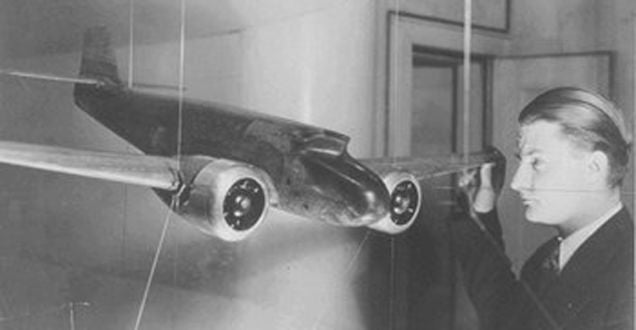 !!!CAPTION ERROR: MAY BE MULTI-LINE OR CONTAIN LINK!!!
!!!CAPTION ERROR: MAY BE MULTI-LINE OR CONTAIN LINK!!!
Johnson was born on February 27, 1910 in !!!error: Indecipherable SUB-paragraph formatting!!! , and showed a precocious skill at aircraft design when he won a prize for designing an aircraft when he was just 13 years old. He began his illustrious 50-year career with Lockheed in 1933, when he joined the company after obtaining a master’s degree in aeronautical engineering from the University of Michigan. His first job was as a tool designer earning $83 a month. Johnson first caught the eye of Lockheed executives when he brought their attention to an instability in the !!!error: Indecipherable SUB-paragraph formatting!!! which he had discovered while performing wind tunnel tests on the twin-engine airliner in graduate school. Johnson proposed a successful fix to the instability problem by suggesting an H tail to replace the traditional stabilizer of the prototype, and his bosses took note. He was then promoted to the rank of aeronautical engineer.
 !!!CAPTION ERROR: MAY BE MULTI-LINE OR CONTAIN LINK!!!
!!!CAPTION ERROR: MAY BE MULTI-LINE OR CONTAIN LINK!!!
Johnson served in many roles as he worked his way up through Lockheed. He served as a flight test engineer, stress analyst, aerodynamicist, and weight engineer, and after just five years he became a chief research engineer. During WWII, German advances in the area of jet aviation had the US Army Air Forces on the back foot, and they were hard pressed to develop their own high performance jet fighters. Johnson said that he could develop a jet fighter in just six months, a promise he made good on when Lockheed introduced the Shooting Star, America’s first operational jet fighter, in January of 1944 after only 143 days of development (the Shooting Star was a development of America’s first jet fighter, the !!!error: Indecipherable SUB-paragraph formatting!!! ). In spite of the remarkably short development time, the Shooting Star was too late to see actual combat in WWII, though it would go on to serve with distinction in the Korean War.
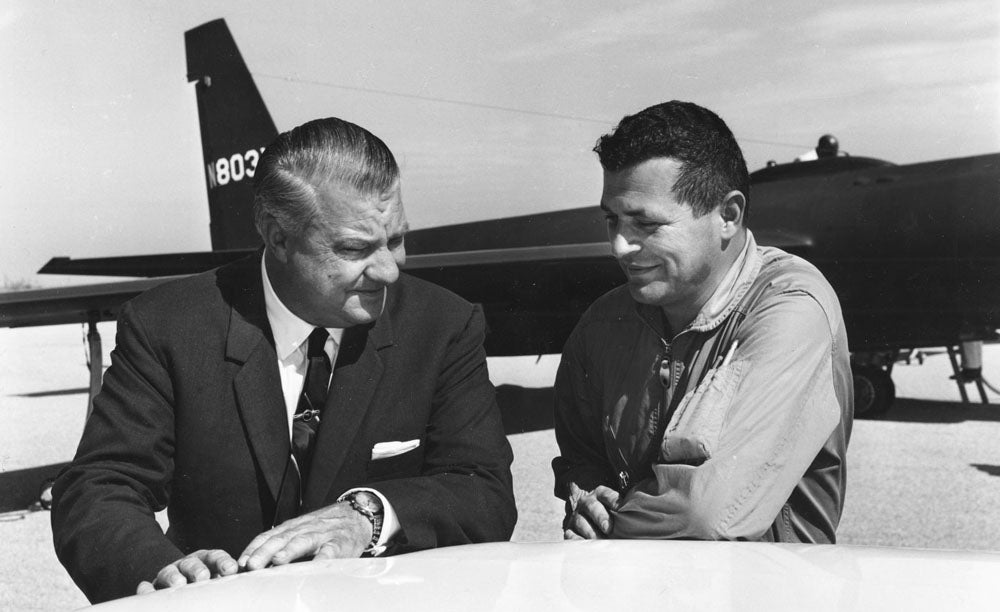
Kelly Johnson with U-2 pilot Gary Powers in 1966, with one of Lockheed’s iconic spy planes in the background. Powers had been shot down over the Soviet Union while flying a U-2 in 1960. (US Air Force)
Johnson’s rise through the Lockheed Corporation continued after the war, and by 1952 he had become the chief engineer of Lockheed’s Burbank plant, and was appointed Vice President of Research and Development in 1956. In 1958, Johnson was named Vice President of Advanced Development Projects (ADP), a position that would garner Johnson his greatest notariety when the ADP became known as the !!!error: Indecipherable SUB-paragraph formatting!!! . Here, Johnson and his team of engineers created many of the aircraft for which he is best known: the supersonic F-104 Starfighter, the high-flying U-2 reconnaissance plane, and the untouchable SR-71 Blackbird. For his work on the F-104 and SR-71, Johnson was awarded two !!!error: Indecipherable SUB-paragraph formatting!!! , an individual feat matched only by another of America’s great aviation pioneers, !!!error: Indecipherable SUB-paragraph formatting!!! . Johnson’s other honors and awards are too numerous to mention. Kelly Johnson retired from Lockheed in 1975, though he continued to work as an advisor to his successor, !!!error: Indecipherable SUB-paragraph formatting!!! .
!!! UNKNOWN CONTENT TYPE !!!

Armed with a laser-guided bomb and a LANTIRN targeting pot, a specially painted F-14D Tomcat assigned to the Blacklions of Fighter Squadron Two One Three (VF-213 conducts a mission over the Persian Gulf in 2005 (US Navy)
December 21, 1970 – The first flight of the Grumman F-14 Tomcat. By the end of WWII, the aircraft carrier had supplanted the battleship as the primary capital ship of the naval battle group. It’s dive bombers and torpedo bombers allowed the carrier to attack both sea and land targets, while fighters provided protection for both the attack aircraft and for the battle group. When long-range anti-ship missiles came into being, particularly those that could be fired from an aircraft hundreds of miles away, protecting the carrier became critical.

The F-111B proved unsuitable for the US Navy, but its swing-wing design influenced the fleet defense fighter the Navy did adopt, the F-14 Tomcat (US Navy)
By 1960, the US Navy began the search for a Fleet Air Defense (FAD) aircraft to intercept attacking enemy aircraft and missiles. US Secretary of Defense !!!error: Indecipherable SUB-paragraph formatting!!! directed the Navy and US Air Force to develop a single aircraft that would serve both branches as part of the !!!error: Indecipherable SUB-paragraph formatting!!! (TFX) program. While the aircraft that eventually came out of that program, the !!!error: Indecipherable SUB-paragraph formatting!!! , proved to be a capable aircraft for the Air Force, the naval variant, the F-111B, did not fit the specialized requirements of the Navy. So the Navy pulled out of the program and forged ahead on their own. They turned to Grumman, who already had a rich history of producing robust carrier aircraft.

A trio of F-14 Tomcat prototypes demonstrate the range of the Tomcat’s wing sweep during a formation flight in 1972 (US Navy)
In 1966, the Navy awarded Grumman a contract to develop their Model 303 design to fill the fleet defense role that was originally intended for the F-111. By 1968, the requirements were set for a tandem, two-seat, twin-engined, air-to-air fighter with a maximum speed of Mach 2.2. Like the F-111, the new fighter was also fitted with variable-sweep wings that could be extended for low-speed flight and takeoff/landing, or swept back for high speed flight. The Tomcat’s wings could sweep from 20-degrees to 68-degrees based on the needs of the flight profile, and the sweep was directed by an internal computer to relieve the workload on the pilot. As the wings retracted, secondary vanes located at the front of the wingbox extended to regulate the aircraft’s center of pressure and help control pitch.

A Grumman F-14A Tomcat of fighter squadron VF-84 Jolly Rogers, assigned to Carrier Air Wing Eight (US Navy)
During the Vietnam War, the Navy discovered that the emphasis on missile weaponry over guns put their fighters at a disadvantage over Russian-built fighters that still relied on machine guns and cannons. Drawing on that experience, Grumman’s new fighter was armed with a built-in !!!error: Indecipherable SUB-paragraph formatting!!! cannon for both aerial dogfighting and close air support for troops on the ground. But with defense of the fleet as its primary mission, the Tomcat’s gun was more of a last ditch weapon. The F-14 was designed around the !!!error: Indecipherable SUB-paragraph formatting!!! missile and the !!!error: Indecipherable SUB-paragraph formatting!!! radar, and two F-14s working together were able to track and destroy targets up to 460 miles away. In addition to its Phoenix missiles, the Tomcat was also armed with !!!error: Indecipherable SUB-paragraph formatting!!! or !!!error: Indecipherable SUB-paragraph formatting!!! air-to-air missiles for close and medium range combat.

The Tomcat began to replace the !!!error: Indecipherable SUB-paragraph formatting!!! in 1974, and took part in the American !!!error: Indecipherable SUB-paragraph formatting!!! at the end of the Vietnam War. The first aerial victories registered by an F-14 occurred in 1981, when Tomcats of !!!error: Indecipherable SUB-paragraph formatting!!! “Black Aces” downed two Libyan !!!error: Indecipherable SUB-paragraph formatting!!! fighters over the Gulf of Sidra. Following the withdrawal from service of the !!!error: Indecipherable SUB-paragraph formatting!!! in the 1990s, the Tomcat demonstrated its versatility when the ground attack mission was added to its arsenal, and F-14s carried out tactical bombing missions and close air support during the Gulf War.
 !!!CAPTION ERROR: MAY BE MULTI-LINE OR CONTAIN LINK!!!
!!!CAPTION ERROR: MAY BE MULTI-LINE OR CONTAIN LINK!!!
The final F-14 combat mission took place in February 2oo5 when Tomcats flying from !!!error: Indecipherable SUB-paragraph formatting!!! !!!error: Indecipherable SUB-paragraph formatting!!! (CVN-71) took part in bombing missions over Iraq. The Navy finally retired the Tomcat in 2006 after 32 years of service and replaced it with the !!!error: Indecipherable SUB-paragraph formatting!!! , which was seen as a less expensive alternative to modernizing the aging F-14. A small number of F-14As still serve the Islamic Republic of Iran Air Force, which received Tomcats during the reign of the Shah. However, to prevent spare parts being sent to Iran after the fall of the Shah, all remaining American Tomcats were scrapped rather than put into mothballs, though a number are still on display around the country.
!!! UNKNOWN CONTENT TYPE !!!

An F-11E of the 20th Tactical Fighter Wing drops bombs over a bombing range (US Department of Defense)
December 21, 1964 – The first flight of the General Dynamics F-111 Aardvark. In the years immediately following WWII, the US Air Force continued the doctrine of high-altitude bombing they had carried out against Germany and Japan during the war. But in May 1960, the Russians used a surface-to-air missile (SAM) to shoot down a high-flying !!!error: Indecipherable SUB-paragraph formatting!!! spy plane over the Soviet Union, and it suddenly became clear that altitude alone was no protection against interception. A change of tactics was in order. The new doctrine called for high-speed, low-level attacks, since low-flying aircraft were harder to detect on radar, and SAMs were less effective because they had less time to lock on a target.

F-111 prototype No. 1 during a test flight (US Air Force)
Both the Air Force and US Navy began looking for an aircraft that could fulfill this new low-altitude penetration role, but Defense Secretary !!!error: Indecipherable SUB-paragraph formatting!!! believed that one aircraft could serve both branches, even though the two had very different requirements. The !!!error: Indecipherable SUB-paragraph formatting!!! (TFX) program was initiated by McNamara in 1961 to find an aircraft for both services. The Air Force received proposals from Boeing, General Dynamics, Lockheed, McDonnell, North American and Republic. General Dynamics, with its swing-wing F-111, was selected. McNamara dictated that General Dynamics first develop the A model for the Air Force, and follow that with a B model modified for use by the Navy. With no experience building carrier aircraft, General Dynamics teamed with Grumman to develop the F-111B, but significant delays, and the Navy’s decision to change from a bomber to a fleet defense fighter with dogfighting capabilities, led the Navy to pull out of the F-111 program and pursue a different aircraft, eventually settling on the swing-wing !!!error: Indecipherable SUB-paragraph formatting!!! .
 !!!CAPTION ERROR: MAY BE MULTI-LINE OR CONTAIN LINK!!!
!!!CAPTION ERROR: MAY BE MULTI-LINE OR CONTAIN LINK!!!
The Aardvark (a nickname that wasn’t made official until 1996) was a very advanced aircraft for its time, and was the world’s first production aircraft to employ variable-sweep wings. It was powered by two afterburning !!!error: Indecipherable SUB-paragraph formatting!!! turbofan engines that gave the tactical bomber a top speed of Mach 2.5 and a combat radius of over 1,300 miles. In keeping with the low-level penetration mission, the F-111 had an automated terrain-following radar that reduced the pilot workload during low level missions. Though the Air Force had asked for tandem seating in the cockpit, the two-man crew in the F-111 sat side by side, which allowed both the pilot and the radar operator to share the radar screen. The seating arrangement also allowed for the use of an ejection capsule rather than individual ejection seats.

An FB-111A of the 509th Bombardment Wing drops Mark 82 high drag practice bombs during a training exercise (US Air Force)
The F-111 was designed with the nuclear mission in mind and was capable of carrying a single nuclear missile or nuclear bombs, but the Aardvark found a niche as a conventional tactical bomber for the Air Force, and could carry a wide range of ordnance to suit the particular mission. The F-111 first saw action in the skies over Vietnam, and after initial mechanical problems that caused some fatal crashes were worked out, the Aardvark ultimately flew over 4,000 sorties with only six combat losses. Following the war, F-111s participated in strikes against Libya in 1986 and during the
!!!error: Indecipherable SUB-paragraph formatting!!!
in 1991. The final F-111 in the US Air Force inventory, an
!!!error: Indecipherable SUB-paragraph formatting!!!
electronic warfare variant, was retired in 1998, though the F-111C served the Royal Australian Air Force until 2010.
!!! UNKNOWN CONTENT TYPE !!!

(Lockheed)
December 22, 1964 – The first flight of the Lockheed SR-71 Blackbird. At the height of the Cold War between the United States and Soviet Union in the years following WWII, the US desperately needed intelligence on Soviet military movements and defense programs. America had launched its first !!!error: Indecipherable SUB-paragraph formatting!!! spy satellite in 1959, but satellites, no matter how good their photographic equipment, still could not replace surveillance aircraft for flexibility in targeting and timely response to rapidly developing global hotspots. But advances in surface-to-air missiles had left even the high-flying !!!error: Indecipherable SUB-paragraph formatting!!! vulnerable to attack so, in 1957, Lockheed began development of an aircraft that could take over the job of spying on the Soviet Union and its satellite countries, a task which became more urgent in 1960 when Central Intelligence Agency pilot !!!error: Indecipherable SUB-paragraph formatting!!! was !!!error: Indecipherable SUB-paragraph formatting!!! by a surface-to-air missile over the Soviet Union while flying a U-2.

Lockheed A-12s lined up outside the Lockheed’s Palmdale, California facility. The A-12 served as the basis for the SR-71. (US Air Force)
The US needed an aircraft that could not only fly higher and faster than even the fastest Soviet aircraft, but one that was also more difficult to spot on radar. Lockheed experimented with technologies to reduce the spy plane’s radar signature, and developed aircraft shapes and coatings that served as the precursor to what we know today as !!!error: Indecipherable SUB-paragraph formatting!!! . The result of that development program was the single-seat !!!error: Indecipherable SUB-paragraph formatting!!! , which first flew in 1962. The A-12 was followed by the SR-71, which offered increased range and more sensors, along with a second crew member to handle the reconnaissance work. While the lighter and faster A-12 could outperform the SR-71, the Blackbird was a more capable aircraft.

The curve of the Earth is visible in this photo taken by pilot Brain Shul from the cockpit of an SR-71 flying at 80,000 feet (US Air Force)
Powered by two
!!!error: Indecipherable SUB-paragraph formatting!!!
continuous bleed afterburning turbojets, the Blackbird could reach Mach 3.3 and fly as high as 80,000 feet, faster than any contemporary fighter aircraft and safe from the surface-to-air missiles of the day. To defend against radar interception, the Blackbird was coated with special radar absorbing paint, and its vertical stabilizers were canted inwards to deflect radar signals. Despite its massive size, the SR-71 had a
!!!error: Indecipherable SUB-paragraph formatting!!!
(RCS) of only 10 square meters. With the combination of its speed, ceiling, and stealth, no SR-71 was ever lost to enemy fire. Though designed to spy on the Soviet Union, no Blackbirds ever flew across Russia, at least not officially. The majority of surveillance missions were flown over North Vietnam from bases in Japan, and other flights were launched from bases in Europe to probe the northern periphery of the Soviet Union.
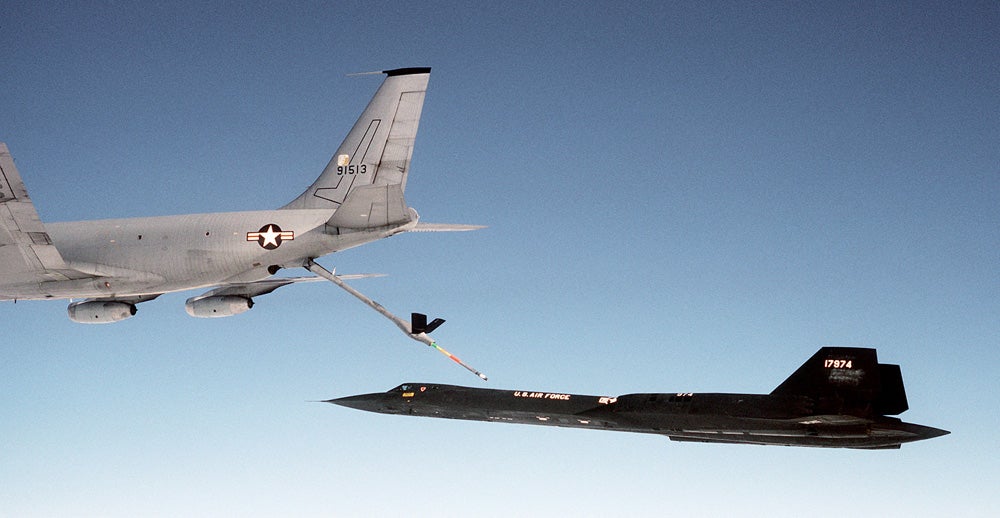
A Lockheed SR-71 takes on fuel from a Boeing KC-135Q during a flight in 1983 (US Air Force)
However, along with the unsurpassed capabilities of the SR-71 came very high operating costs, and this ultimate spy plane became a political issue in an era of shrinking budgets and competition for government funds. In 1989, the Blackbird was retired from service, even at a time of escalating tensions in the Middle East when it could have performed valuable reconnaissance duties in the lead up to the !!!error: Indecipherable SUB-paragraph formatting!!! . When the US government realized that it still had a need for the high-flying spy plane, the SR-71 was updated with real-time data transmission capabilities and reactivated in 1993, in spite of stiff opposition from the US Air Force who said they didn’t have the funds to operate it. The Air Force also claimed that the Blackbird competed with unmanned reconnaissance projects currently under development. After another political battle over funding the aircraft, the SR-71 was permanently canceled in 1998, and the last two airworthy Blackbirds were shifted to NASA for research. The book on the Blackbird was finally closed on October 9, 1999 when the last flying aircraft, an SR-71A (61-7980/NASA 844), landed at Edwards AFB in California and was placed in storage with the other NASA Blackbird. All remaining aircraft (as far we know) are now housed at aviation museums around the country.
!!! UNKNOWN CONTENT TYPE !!!

The Rutan Voyager in flight. Note the damaged left wingtip. (NASA)
December 23, 1986 – The Rutan Voyager completes the first non-stop flight around the world without refueling. Aviation history is filled with stories of pilots and aircraft designers who pushed the boundaries of flight, and some of the greatest advances have been made in the quest to fly higher, faster, or farther. With the advent of aerial refueling, non-stop flights around the world had been become relatively commonplace for military aircraft, and the longest non-stop, unrefueled flight at the time took place in 1962, when the crew of a US Air Force !!!error: Indecipherable SUB-paragraph formatting!!! flew from Okinawa to Spain, a distance of 12,532 miles, or about half way around the world. But nobody had ever piloted a plane all the way around the world on a single load of fuel for the simple reason that there was no aircraft that could make such a flight. It would take a truly visionary aircraft designer to create a round-the-world aircraft, and !!!error: Indecipherable SUB-paragraph formatting!!! , well known for his unorthodox and brilliant aircraft designs, was just the person to build it.

Jeanna Yeager and Dick Rutan (WTOP)
The idea for a world-circling flight began in 1981 during a lunch meeting with Burt Rutan, his brother Dick who was a !!!error: Indecipherable SUB-paragraph formatting!!! pilot, and pilot !!!error: Indecipherable SUB-paragraph formatting!!! . As the three discussed the idea of a nonstop flight around the globe, the basic outline for the world-spanning aircraft was sketched out on a napkin. The Voyager featured two long booms connected by a long, slender wing and forward canards. Room for the pilots in the central fuselage was at a bare minimum, as all available space in the plane was taken up with fuel. The Voyager was built of fiberglass, carbon fiber and Kevlar and weighed only 939 pounds empty. Fully loaded with fuel, its weight increased tenfold to 9,695 pounds. Power was provided by two four-cylinder Continental engines, one in the nose and one in the rear.

Rutan and Yeager inside the cramped cockpit during the flight (NASA)
The historic flight began on December 14, 1986 with a takeoff from the longest runway at Edwards Air Force Base in California since the Voyager, laden with fuel, required 14,200 feet of runway to become airborne. During takeoff, the wingtips scraped the ground, damaging the wings and breaking off the winglets, but engineers decided to continue the flight. Rutan and Yeager were forced to maneuver around bad weather, and had to fly around Libya since they did not have permission to overfly the unfriendly African nation. The Voyager returned to Edwards Air Force Base on December 23 after nine days in the air. When it touched down, the aircraft had just 106 pounds of fuel remaining in the tanks, having burned 98.5% of the fuel they departed with. Rutan’s and Yeager’s average speed was 115 mph, and the flight covered 26,366 statute miles at an average altitude of 11,000 feet.
Now that the non-stop circumnavigation challenge had been met, the only thing left to do was to complete the flight in a shorter time, or make the flight alone. Rutan’s and Yeager’s nine-day record was finally broken by adventurer
!!!error: Indecipherable SUB-paragraph formatting!!!
in another Burt Rutan design, the jet-powered
!!!error: Indecipherable SUB-paragraph formatting!!!
, on February 11, 2006. Fosset completed the circumnavigation in a mere 2 days and 19 hours, covering a distance of 25,767 miles. The Voyager is now on display at the Smithsonian National Air and Space Museum in Washington, D.C.
!!! UNKNOWN CONTENT TYPE !!!

A B-1B Lancer from the 7th Bomb Wing based at Dyess Air Force Base in Texas (Tim Shaffer)
December 23, 1974 – The first flight of the Rockwell B-1 Lancer. Since the dawn of military aviation, air forces have worked continually to improve on earlier designs and introduce new technologies to stay one step ahead of their opponents. But when innovations in air defense outstrip innovations in aircraft design, or other technologies arise to supplant a new system entirely, it’s entirely possible that the mission for which an aircraft was designed simply doesn’t exist any more, even after the expenditure of millions or even billions of dollars. Such was the case for the B-1 Lancer, an aircraft that was developed to replace a bomber that remains in the US Air Force inventory to this day. During the course of the Lancer’s development, its mission changed, it was canceled, then resurrected, and it now serves admirably in a role for which it was not initially conceived.

Rockwell B-1A prototype, painted in anti-flash white (US Air Force)
Work on a new Mach 2 bomber began in the 1960s as a supersonic replacement for the !!!error: Indecipherable SUB-paragraph formatting!!! when it appeared that the B-52 was entering its twilight as a long-range bomber for the !!!error: Indecipherable SUB-paragraph formatting!!! . Initially, the Air Force hoped to procure the !!!error: Indecipherable SUB-paragraph formatting!!! , but advances in Soviet anti-aircraft missile technology negated the high flying, high speed advantages of the Mach 3 bomber, and Air Force doctrine shifted to low altitude, high-speed penetration attacks. Following the cancellation of the XB-70 in 1961, numerous studies were undertaken to develop a new low-level bomber, as the B-52, which had been designed for high-altitude strategic bombing missions such as those carried out during WWII, was unsuited for low level penetration. But those initial studies produced no viable aircraft, and the entire program was defunded by Defense Secretary !!!error: Indecipherable SUB-paragraph formatting!!! in 1968.
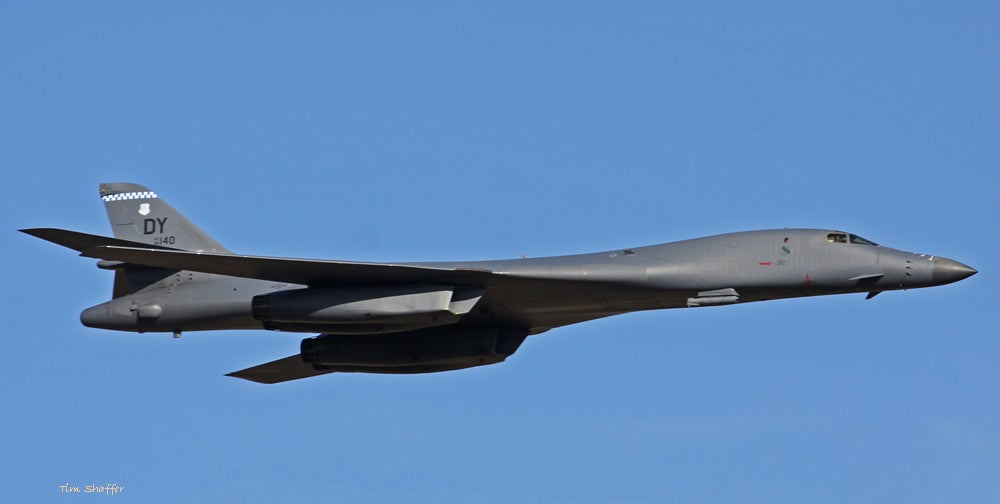
B-1B Lancer from Dyess Air Force Base with wings swept back for high-speed flight (Tim Shaffer)
The program was then resurrected by President Richard Nixon in the early 1970s, and the !!!error: Indecipherable SUB-paragraph formatting!!! design, which featured four engines and a variable-sweep wing for both low level and high altitude, high speed missions, was selected as the B-1A. Rockwell produced four prototypes, but the program was canceled once again by the Carter Administration in 1977, citing both high costs and the existence of cruise missiles that could be launched from existing B-52s. It was thought that the missiles could perform a similar mission for much less money. But the whole point of the long and tortuous development program was to create a manned system, and the on-again, off-again bomber program was once again raised from the dead, this time in 1981 by President Ronald Reagan, who was seeking to build up US military forces to counter the Soviet Union.
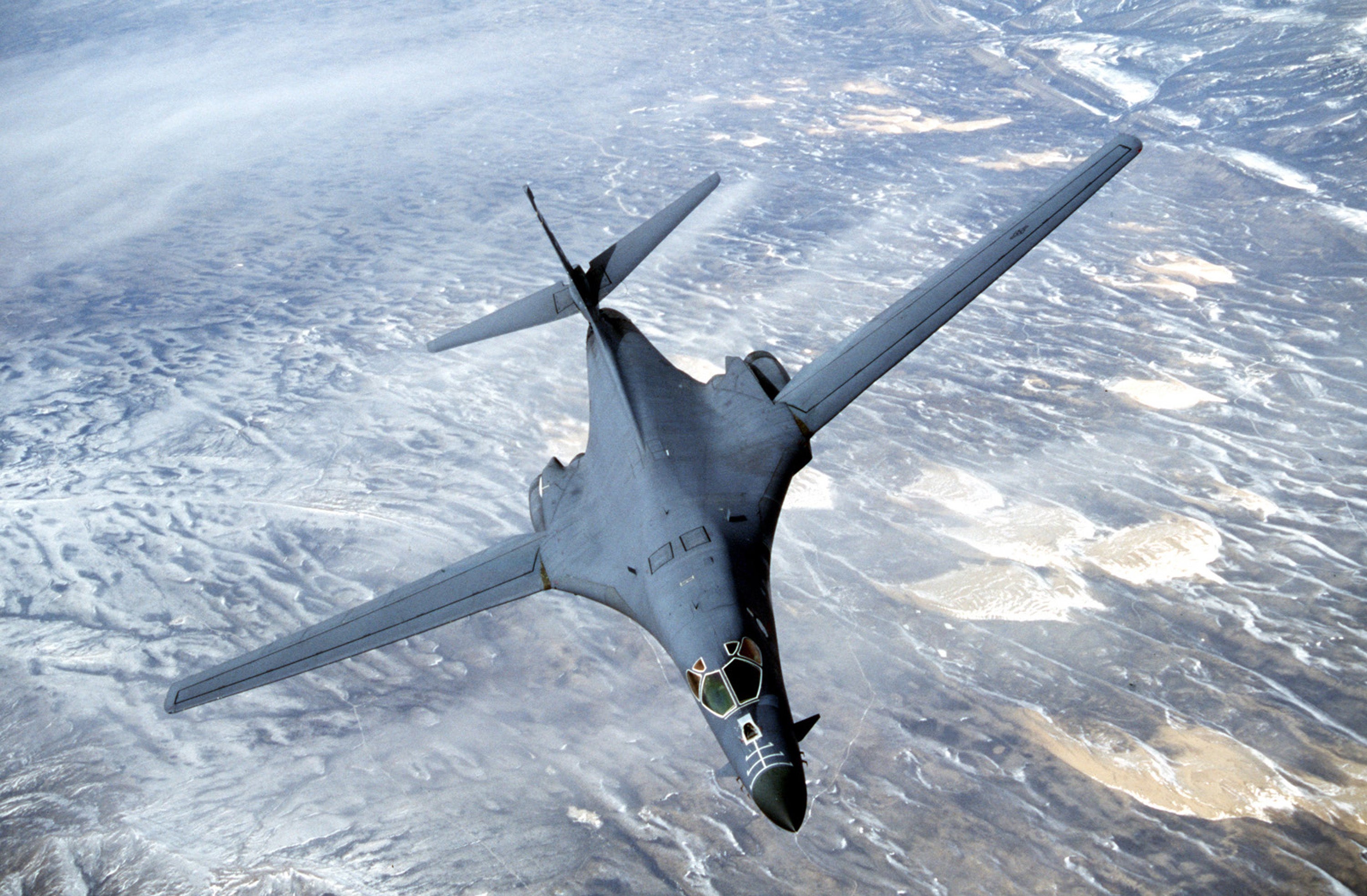
A B-1B in flight over Afghanistan (US Air Force)
The restart gave Rockwell a chance to revisit the design, and the newly christened B-1B differed from its predecessor with a payload increased to 74,000 pounds, improved radar, and a reduced radar cross section (RCS), changes that also led to a reduction of the maximum speed to Mach 1.2. The B-1B entered service in 1985 and saw its first combat during !!!error: Indecipherable SUB-paragraph formatting!!! in 1998. The capability of dropping highly accurate !!!error: Indecipherable SUB-paragraph formatting!!! bombs, coupled with an excellent loiter time over the battlefield, make the B-1B an indispensable tool for the Air Force in the ongoing war in Afghanistan and the fight against !!!error: Indecipherable SUB-paragraph formatting!!! in Syria. Though the B-52 keeps flying, and may actually reach the century mark of service, the B-1B is expected to keep flying until at least the 2030s, when it is slated to be replaced by the planned !!!error: Indecipherable SUB-paragraph formatting!!! !!!error: Indecipherable SUB-paragraph formatting!!! .
!!! UNKNOWN CONTENT TYPE !!!
 !!!CAPTION ERROR: MAY BE MULTI-LINE OR CONTAIN LINK!!!
!!!CAPTION ERROR: MAY BE MULTI-LINE OR CONTAIN LINK!!!
December 23, 1941 – The first flight of the Douglas C-47 Skytrain. When the airplane arrived as a weapon of war in WWII, it fundamentally changed the way wars are fought. But when compiling lists of “greatest” warplanes, we tend to focus on bombers that pounded enemy cities, or fighters that wheeled and turned over the battlefield, fending off attacking bombers or engaging in dogfights against enemy fighters. But it would not be hyperbole to say that the humble Douglas C-47 played an equal, or perhaps even more important, role in winning WWII for the Allies than any bomber or fighter.
 !!!CAPTION ERROR: MAY BE MULTI-LINE OR CONTAIN LINK!!!
!!!CAPTION ERROR: MAY BE MULTI-LINE OR CONTAIN LINK!!!
The Skytrain, or Dakota as it was known to the British, began its storied career as the !!!error: Indecipherable SUB-paragraph formatting!!! commercial airliner, which first flew in 1935. The DC-3 helped usher in the age of the passenger airliner, but, for all its success, it was the military version that would have the greatest impact on world history. Externally, the DC-3 and C-47 (or, in US Navy parlance, the R4D) are almost indistinguishable. Internally, the C-47 was strengthened to allow for the handling of heavy cargo, and the seats were removed and replaced with utility seats along the walls that could be folded during cargo operations. A large door was added to the rear side of the fuselage so cargo could be loaded and unloaded.

A pair of C-47 Skytrains in the air over France in 1945 (US Air Force)
Skytrains, or “Gooney Birds” as they were affectionately called, played a vital role early in the war by flying supplies over the Himalayas, known to pilots as “The Hump,” to supply Nationalist Chinese forces fighting the Japanese. Later in the war, entire Allied armies were supported by the air in the jungles of southeast Asia by C-47s that delivered supplies to areas that were inaccessible by trucks or other ground transport. In Europe, C-47s dropped vital supplies for the beleaguered and surrounded forces in Bastogne during the !!!error: Indecipherable SUB-paragraph formatting!!! , and towed gliders and carried paratroops in airborne assaults like !!!error: Indecipherable SUB-paragraph formatting!!! . But the Skytrain is perhaps best known for its role in the predawn hours of D-Day, June 6, 1944, when an armada of Skytrains and Dakotas, arrayed in consecutive V-formations nine planes wide in a line that stretched 300 miles, carried nearly 20,000 airborne troops into Normandy to help clear the way for the invasion forces that would arrive after sunrise. Without any exaggeration, General Dwight D. Eisenhower, Supreme Commander of Allied forces in Europe, said that the C-47 was one of the major tools that helped win the war for the Allies.

C-47s lined up on the tarmac at Tempelhof Airport during the Berlin Airlift in 1948 (US Air Force)
The end of WWII was by no means the end of the road for the C-47. It took part in the
!!!error: Indecipherable SUB-paragraph formatting!!!
, served with distinction in the Korean War, and continued its critical role in the Vietnam War, where some C-47s were modified into flying gunships designated AC-47. The gunships, nicknamed “Spooky” or “Puff the Magic Dragon,” carried three 7.62mm mini guns and ten .30 caliber Browning machine guns for ground attack and close air support for troops on the ground. While Douglas built just over 600 DC-3 airliners more than 10,000 C-47s were produced, and many are still in use today. The rugged airframe has withstood the test of time, and some continue to fly with upgraded turboprop engines. There is every reason to believe that the airplane that helped revolutionize air travel and helped win a war will still be flying 100 years after it first took to the skies.
!!! UNKNOWN CONTENT TYPE !!!
 !!!CAPTION ERROR: MAY BE MULTI-LINE OR CONTAIN LINK!!!
!!!CAPTION ERROR: MAY BE MULTI-LINE OR CONTAIN LINK!!!
December 24, 1952 – The first flight of the Handley Page Victor. World War II effectively ended in early August 1945 when the United States dropped atomic bombs on the Japanese cities of Hiroshima and Nagasaki. Though it would be three more weeks before the Japanese officially surrendered, the world had entered the age of nuclear weapons. For a while, the US was the only nation that possessed the atomic bomb, though that monopoly did not last long. The Soviet Union detonated their first atomic bomb bomb in August 1949, and England followed suit when they detonated their first atomic bomb in October 1952.

The V Bombers in flight: the Avro Vulcan, the Vickers Valiant, and the Handley Page Victor. (Author unknown)
Concurrent with England’s decision to develop nuclear weapons, the British Air Ministry issued requirements for new jet-powered bombers that could carry the large atomic bombs, as the older piston-powered aircraft were not up to the task and had become obsolete by the 1950s. Air Ministry specification B.35/46 called for a four-engine, swept-wing jet bomber that could cruise at 580 mph and have a ceiling of at least 55,000 feet, as high-altitude bombing was still standard practice. The new bomber would have to be able to carry a 10,000 pound “special gravity bomb” at a range of up to 1,700 miles. Three very different operational bombers came out of the request, and they came to be known as the !!!error: Indecipherable SUB-paragraph formatting!!! : the !!!error: Indecipherable SUB-paragraph formatting!!! , !!!error: Indecipherable SUB-paragraph formatting!!! and Handley Page Victor.
 !!!CAPTION ERROR: MAY BE MULTI-LINE OR CONTAIN LINK!!!
!!!CAPTION ERROR: MAY BE MULTI-LINE OR CONTAIN LINK!!!
The Victor was the third in the series, and was ultimately the last to be retired. It was powered by four turbojets housed in the wing roots, and the wing itself was a unique design for the time. Where the Vulcan experimented with a delta wing configuration, the Victor employed an innovative crescent-shaped wing designed by Handley Page’s aerodynamicist !!!error: Indecipherable SUB-paragraph formatting!!! . The idea behind the unique wing shape was an effort to maintain the same !!!error: Indecipherable SUB-paragraph formatting!!! as the pressure wave moved across the span of the wing. The fuselage was streamlined down to a point at the front, and the heavily swept tailplane featured a distinct dihedral, or upward tilt. The large bulge under the aircraft’s cockpit housed the targeting radar, landing gear, and an auxiliary position for the bomb aimer. The first Victor, the B.1, was powered by four !!!error: Indecipherable SUB-paragraph formatting!!! turbojets, while the later B.2 received four !!!error: Indecipherable SUB-paragraph formatting!!! turbofans which increased the Victor’s maximum speed to 627 mph. The Victor B.1 entered service in 1957, followed by the B.2 in 1961.
 !!!CAPTION ERROR: MAY BE MULTI-LINE OR CONTAIN LINK!!!
!!!CAPTION ERROR: MAY BE MULTI-LINE OR CONTAIN LINK!!!
Though initially intended as a high altitude bomber, advances in Soviet air defenses required a change in tactics to low-level, high-speed penetration of enemy airspace. While the Victor performed the new mission well, the development of fatigue cracks from these more strenuous missions led to the bomber’s withdrawal from the strategic bombing role. Remaining Victors, including the B.2R reconnaissance variants, were converted to aerial tankers, with modifications made to the wings to help prevent wing stresses that were causing the fatigue cracks. The more traditional Vickers Valiant was the only of the V bombers to drop live nuclear weapons during testing, but the Victor and Vulcan both played important roles in the
!!!error: Indecipherable SUB-paragraph formatting!!!
of 1982. As part of
!!!error: Indecipherable SUB-paragraph formatting!!!
, Vulcan bombers flying from England were staged at Ascension Island in the South Atlantic, and the 8,000 mile round trip to the Falklands was made possible with numerous refuelings provided by Victor tankers. Victors also took part in the refueling of coalition aircraft during the
!!!error: Indecipherable SUB-paragraph formatting!!!
of 1991, but they were retired in 1993.
!!! UNKNOWN CONTENT TYPE !!!
!!! UNKNOWN CONTENT TYPE !!!
Short Takeoff
!!! UNKNOWN CONTENT TYPE !!!

(NASA)
December 21, 2017 – The death of Bruce McCandless II, an American astronaut and the first man to “walk” untethered in space. The son of !!!error: Indecipherable SUB-paragraph formatting!!! , a Congressional Medal of Honor recipient for his service in the Pacific in WWII, McCandless II graduated from the US Naval Academy in 1958 before serving as an active duty fighter pilot and instructor. He was the youngest member of !!!error: Indecipherable SUB-paragraph formatting!!! , and served as the !!!error: Indecipherable SUB-paragraph formatting!!! for the Apollo 11 mission to the Moon. Later, he served as a backup pilot for the first Skylab mission and CAPCOM for !!!error: Indecipherable SUB-paragraph formatting!!! and !!!error: Indecipherable SUB-paragraph formatting!!! . McCandless finally went to space as a mission specialist on board the space shuttle !!!error: Indecipherable SUB-paragraph formatting!!! on !!!error: Indecipherable SUB-paragraph formatting!!! on February 3, 1984, where he made the first flight of the !!!error: Indecipherable SUB-paragraph formatting!!! , which he had helped develop during his time with Skylab. McCandless went to space a second and final time on board the shuttle !!!error: Indecipherable SUB-paragraph formatting!!! on !!!error: Indecipherable SUB-paragraph formatting!!! in 1990 which placed the !!!error: Indecipherable SUB-paragraph formatting!!! into Earth orbit.
!!! UNKNOWN CONTENT TYPE !!!

(US Government)
December 21, 1990 – The death of Clarence “Kelly” Johnson, the one-time head of Lockheed’s Advanced Development Projects, better known as the !!!error: Indecipherable SUB-paragraph formatting!!! , and one of the most influential and successful aircraft design engineers in American history. His work for !!!error: Indecipherable SUB-paragraph formatting!!! produced some of the world’s iconic aircraft, including the !!!error: Indecipherable SUB-paragraph formatting!!! , America’s first operational jet fighter the !!!error: Indecipherable SUB-paragraph formatting!!! , and the !!!error: Indecipherable SUB-paragraph formatting!!! , America’s first supersonic jet fighter. As head of the Skunk Works, Johnson oversaw the development of the !!!error: Indecipherable SUB-paragraph formatting!!! reconnaissance aircraft, the !!!error: Indecipherable SUB-paragraph formatting!!! , and the remarkable !!!error: Indecipherable SUB-paragraph formatting!!! , the first production aircraft to exceed Mach 3. Among his other achievements, Johnson was twice awarded the prestigious !!!error: Indecipherable SUB-paragraph formatting!!! .
!!! UNKNOWN CONTENT TYPE !!!
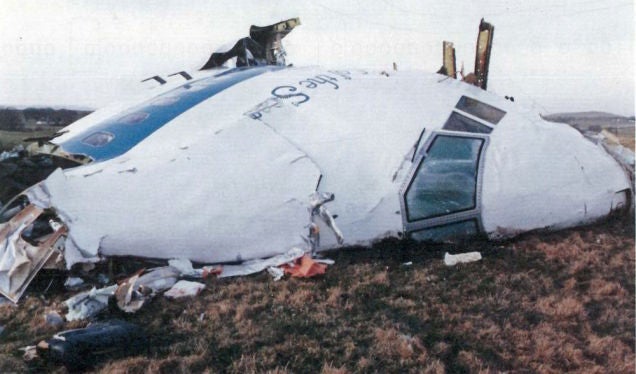
(UK Government)
December 21, 1988 – Pan Am Flight 103 is brought down by a bomb over Lockerbie, Scotland. Pan Am Flight 103 was a regularly scheduled flight from Frankfurt to Detroit via London and New York. After departing from London Heathrow, the !!!error: Indecipherable SUB-paragraph formatting!!! (N739PA) was brought down by a bomb that had been placed in the forward cargo hold. The crash killed all 270 passengers and crew, as well as 11 people on the ground. Investigators alleged that two Libyans, working on the orders of Libyan leader !!!error: Indecipherable SUB-paragraph formatting!!! , had planted the bomb. Following United Nations sanctions against Libya, Gaddafi turned over the two men for trial in the Netherlands, and one, !!!error: Indecipherable SUB-paragraph formatting!!! , was found guilty of 270 counts of murder and imprisoned for life. In 2003, Gadaffi accepted responsibility for the attack and paid compensation to the families of the victims, and al-Megrahi was freed from prison in 2009 on compassionate grounds after a diagnosis of prostate cancer. He died in 2012.
!!! UNKNOWN CONTENT TYPE !!!

(Ralf Manteufel)
December 21, 1988 – The first flight of the Antonov An-225 Mriya , the longest and heaviest airplane ever constructed. Possessing the largest wingspan of any operational aircraft in service, Mriya’s wingspan is only exceeded by the !!!error: Indecipherable SUB-paragraph formatting!!! (“Spruce Goose”). The Mriya has a maximum takeoff weight of 640 tons, and holds the absolute world records for a single item payload of 418,834 pounds and an airlifted total payload of 253,820 pounds. Originally developed as a carrier for the Soviet !!!error: Indecipherable SUB-paragraph formatting!!! space shuttle program, only one An-225 was built. A second aircraft was under construction but abandoned due to lack of funding and no commercial interest. However, the Russian government has expressed interest in completing the second Mriya and developing it into a midair launch platform.
!!! UNKNOWN CONTENT TYPE !!!

(NASA)
December 21, 1968 – The launch of Apollo 8.
Overshadowed by
!!!error: Indecipherable SUB-paragraph formatting!!!
, the mission that landed the first man on the Moon on July 20, 1969, Apollo 8 had its own set of important milestones that paved the way for the first lunar landing. Astronauts
!!!error: Indecipherable SUB-paragraph formatting!!!
,
!!!error: Indecipherable SUB-paragraph formatting!!!
(commander of the ill-fated Apollo 13 mission) and
!!!error: Indecipherable SUB-paragraph formatting!!!
were the first humans to leave Earth orbit, the first to see the planet Earth in its entirety, the first to make a direct observation of the far side of the Moon, and the first to witness
!!!error: Indecipherable SUB-paragraph formatting!!!
. After a 3-day flight, the astronauts made 10 orbits of the Moon and made a Christmas Eve broadcast to the Earth during which they read from the Book of Genesis. Apollo 8 returned to Earth on December 27.
!!! UNKNOWN CONTENT TYPE !!!

(Deutsches Bundesarchiv)
December 21, 1936 – The first flight of the Junkers Ju 88, a twin-engined multi-role bomber that entered service with the Luftwaffe at the outbreak of WWII. The Ju 88 was designed as a !!!error: Indecipherable SUB-paragraph formatting!!! (high speed bomber) that was intended to be capable of outrunning enemy fighters and would not require fighter protection of its own. Though this concept wasn’t entirely successful in practice, the Ju 88 nevertheless served throughout the war and was one of the Luftwaffe’s most effective bombers. It also served as a dive bomber, a night fighter with the addition of the !!!error: Indecipherable SUB-paragraph formatting!!! , a torpedo bomber, and a reconnaissance aircraft. Late in the war, in a program called !!!error: Indecipherable SUB-paragraph formatting!!! , unmanned Ju 88s were loaded with bombs and mated to a manned fighter that flew both aircraft to the target, whereupon the Ju 88 was released. More than 15,000 88s were produced during the war.
!!! UNKNOWN CONTENT TYPE !!!
 !!!CAPTION ERROR: MAY BE MULTI-LINE OR CONTAIN LINK!!!
!!!CAPTION ERROR: MAY BE MULTI-LINE OR CONTAIN LINK!!!
December 22, 1976 – The first flight of the Ilyushin Il-86,
the first wide-body airliner to be produced by the Soviet Union. The introduction of the Il-86 was planned to coincide with the 1980 Summer Olympics held in Moscow, but a protracted 10-year development program failed to reach that goal. Though much of the technology in the Il-86, including the
!!!error: Indecipherable SUB-paragraph formatting!!!
turbofans, was more reminiscent of the 1960s, the Il-86 went on to serve for more than 30 years as a safe and reliable airliner, suffering no fatal accidents during its service life. A total of 106 were produced, and all have since been retired except for four that remain in service with the Russian Air Force. The Il-86 was subsequently developed into the much more modern
!!!error: Indecipherable SUB-paragraph formatting!!!
.
!!! UNKNOWN CONTENT TYPE !!!

(NASA)
December 22, 1966 – The first flight of the Northrop HL-10. Along with the !!!error: Indecipherable SUB-paragraph formatting!!! , Northrop designed the HL-10 as part of the experimental heavy lifting bodies program run by !!!error: Indecipherable SUB-paragraph formatting!!! during the 1960s to investigate the viability of aircraft in which the fuselage, rather than wings, provided the lift necessary for flight. The HL-10 was carried aloft by a !!!error: Indecipherable SUB-paragraph formatting!!! and then powered by a rocket engine after separation from the mother ship. Over the course of 37 test flights, the HL-10 reached a top speed of Mach 1.86 and a maximum altitude of 90,030 feet. HL-10 project engineer !!!error: Indecipherable SUB-paragraph formatting!!! formulated a plan to fly the HL-10 into space using launch hardware left over from the canceled Apollo program, but that plan never came to fruition. Only one HL-10 was produced, and it is on display at the !!!error: Indecipherable SUB-paragraph formatting!!! at Edwards Air Force Base in California.
!!! UNKNOWN CONTENT TYPE !!!

(US Air Force)
December 22, 1949 – The first flight of the North American F-86D Sabre.
The F-86D, commonly called the “Sabre Dog” or “Dog Sabre,” was a transonic, all-weather interceptor that served the US Air Force from 1951 until its retirement in 1961. Derived from the earlier
!!!error: Indecipherable SUB-paragraph formatting!!!
, the F-86D was actually much larger, had a more powerful engine, and was fitted with a Hughes AN/APG-36 radar in a nose cone positioned above the air intake. Despite its resemblance to the earlier Sabre, the D model shared only 25% commonality with its smaller sibling. The F-86D was the first US Air Force fighter to have an all-missile and rocket armament, and the first all-weather interceptor to have a single pilot. A total of 2,847 F-86Ds were built.
!!! UNKNOWN CONTENT TYPE !!!
 !!!CAPTION ERROR: MAY BE MULTI-LINE OR CONTAIN LINK!!!
!!!CAPTION ERROR: MAY BE MULTI-LINE OR CONTAIN LINK!!!
December 22, 1945 – The first flight of the Beechcraft Bonanza.
Introduced in 1947, the Bonanza remains in production today, and this continuous run is the longest of any aircraft in history. Beechcraft has built more than 17,000 Bonanzas of all variants. One of two all-metal general aviation aircraft to emerge after WWII (the other being the
!!!error: Indecipherable SUB-paragraph formatting!!!
), the Bonanza was a relatively advanced aircraft for its day, and featured a system that connected the yoke and rudder controls allowing novice pilots to execute
!!!error: Indecipherable SUB-paragraph formatting!!!
using just the yoke. The Bonanza also pioneered the use of a V-tail in civilian aviation, though crashes by less skilled pilots led Beechcraft to offer a traditional tail configuration beginning in 1959.
!!! UNKNOWN CONTENT TYPE !!!
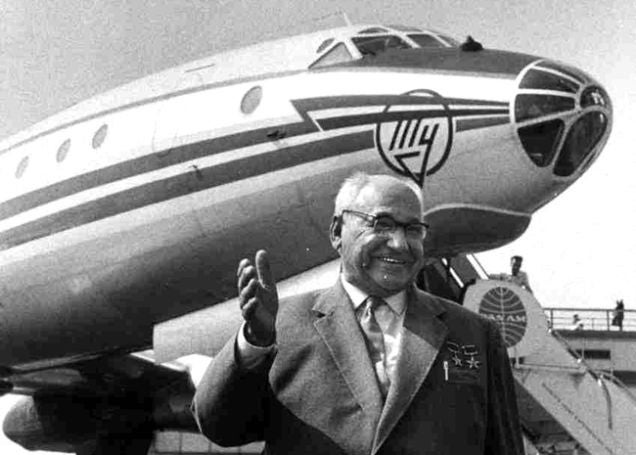
(Author unknown)
December 23, 1972 – The death of Andrei Tupolev,
a pioneer in Russian aviation and the designer of over 100 aircraft. From 1929 until his death in 1972, Tupolev was the leading designer at the Central Aerohydrodynamic Institute, known as
!!!error: Indecipherable SUB-paragraph formatting!!!
. On orders from Soviet General Secretary
!!!error: Indecipherable SUB-paragraph formatting!!!
, Tupolev was arrested in 1937 on charges of sabotage and espionage, but released in 1941 to continue his work, which included the reverse engineering of an American
!!!error: Indecipherable SUB-paragraph formatting!!!
. Designated the
!!!error: Indecipherable SUB-paragraph formatting!!!
, it was the first Soviet aircraft capable of dropping a nuclear weapon. Tupolev is perhaps best known for his design of the
!!!error: Indecipherable SUB-paragraph formatting!!!
bomber, known to the NATO as the Bear. For his life’s work, Tupolev was honored by both the British Royal Aeronautical Society and the American Institute of Aeronautics and Astronautics, and was named a Hero of Socialist Labor on three occasions.
!!! UNKNOWN CONTENT TYPE !!!

(US Air Force)
December 23, 1966 – The first flight of the Dassault Mirage F1.
Developed as a successor to the
!!!error: Indecipherable SUB-paragraph formatting!!!
series of fighters, the F1 entered service with the French
Armée de l’Air
in 1974 and remained France’s main frontline interceptor until the introduction of the
!!!error: Indecipherable SUB-paragraph formatting!!!
in 1982. Unlike its delta-wing predecessors, the all-weather interceptor F1 uses a traditional swept wing arrangement, and was produced in both one-and two-seat versions, as well as a reconnaissance variant. The F1 was exported to 13 countries, and was retired by the French in 2014, though it remains in service with a handful of nations. More than 720 F1s were produced between 1969 and 1992.
!!! UNKNOWN CONTENT TYPE !!!

(US Air Force)
December 23, 1953 – The unofficial first flight of the Lockheed XFV.
Nicknamed the
Salmon
, likely after Lockheed chief test pilot Herman “Fish” Salmon who performed the flight tests, the XFV was a vertical takeoff and landing (VTOL) fighter that was designed to land and take on its tail with the intention of operating from the decks of ships to provide protection for oceangoing convoys. The XFV was powered by a 5,332 hp
!!!error: Indecipherable SUB-paragraph formatting!!!
turboprop engine that drove three-bladed
!!!error: Indecipherable SUB-paragraph formatting!!!
. The tail was a disitinctive cruciform pairing of two V-tails, and the fighter was designed to land on fixed gear attached to the tailplane. Testing was carried out using traditional fixed landing gear, and the first flight occurred accidentally when Salmon taxied beyond takeoff speed. The official first flight took place on June 16, 1954. The XFV never took off or landed vertically as designed, though a series of transitions from level to vertical flight were carried out before the project was cancelled in 1955.
!!! UNKNOWN CONTENT TYPE !!!
 !!!CAPTION ERROR: MAY BE MULTI-LINE OR CONTAIN LINK!!!
!!!CAPTION ERROR: MAY BE MULTI-LINE OR CONTAIN LINK!!!
December 23, 1939 – The death of Anthony Fokker. Dutchman Anton Herman Gerard “Anthony” Fokker was born on April 6, 1890 in the Netherlands Indies and was an aviation pioneer, pilot, and aircraft manufacturer. During WWI, Fokker produced some of the most famous German aircraft, including the !!!error: Indecipherable SUB-paragraph formatting!!! triplane which became synonymous with !!!error: Indecipherable SUB-paragraph formatting!!! , better known as the Red Baron, and the !!!error: Indecipherable SUB-paragraph formatting!!! biplane fighter (which was designed by !!!error: Indecipherable SUB-paragraph formatting!!! ). The !!!error: Indecipherable SUB-paragraph formatting!!! which ended WWI prohibited Germany from producing warplanes, so Fokker took his business to the Netherlands where he developed the famous !!!error: Indecipherable SUB-paragraph formatting!!! . Fokker moved to the US in 1927, but died of meningitis at age 49.
!!! UNKNOWN CONTENT TYPE !!!
 !!!CAPTION ERROR: MAY BE MULTI-LINE OR CONTAIN LINK!!!
!!!CAPTION ERROR: MAY BE MULTI-LINE OR CONTAIN LINK!!!
December 24, 2017 – The first flight of the AVIC AG600. With a wingspan of 127 feet, a length of 121 feet and a maximum takeoff weight of 53 tons, the AG600 is currently the largest amphibious aircraft in the world. Designed with both a flying boat hull and retractable landing gear, the AG600 was built to serve both military and civilian roles, with accommodations for up to 50 passengers or the ability to drop 12 tons of water during firefighting operations. As a military aircraft, the AG600 is planned to provide reconnaissance and search and rescue capabilities with a range of 3,418 miles. The state-owned Aviation Industry Corporation of China has received 17 orders for the AG600 to date.
!!! UNKNOWN CONTENT TYPE !!!

(US Air Force)
December 24, 1937 – The first flight of the Macchi C.200 Saetta , a single-engine fighter produced by Aeronautica Macchi ( !!!error: Indecipherable SUB-paragraph formatting!!! ) that served the Italian Air Force ( Regia Aeronautica ) throughout WWII. The Saetta ( Arrow ) had excellent flying characteristics, and its all-metal construction and air-cooled engine made it a rugged fighter ideal for both air-to-air and ground attack missions, though it lacked sufficient power and armament when compared to many contemporary fighters. Still, the C.200 flew more missions than any other Italian fighter, and its pilots achieved a kill-to-loss ratio of 88-15 in fighting over Russia.
!!! UNKNOWN CONTENT TYPE !!!
Connecting Flights
!!! UNKNOWN CONTENT TYPE !!!
!!! UNKNOWN CONTENT TYPE !!!
!!! UNKNOWN CONTENT TYPE !!!
!!! UNKNOWN CONTENT TYPE !!!
!!! UNKNOWN CONTENT TYPE !!!
If you enjoy these Aviation History posts, please let me know in the comments. And if you missed any of the past articles, you can find them all at
!!!error: Indecipherable SUB-paragraph formatting!!!
. You can also find more stories about aviation, aviators and airplane oddities at
!!!error: Indecipherable SUB-paragraph formatting!!!
.
!!! UNKNOWN CONTENT TYPE !!!
 facw
> ttyymmnn
facw
> ttyymmnn
12/24/2019 at 12:45 |
|
Lots of good planes today! Hard to go wrong with the F-14, SR-71, B-1, and Victor, all favorites of mine.
We didn’t scrap all of the F-14s though, besides the ones at museums and gate guardians , I think there are still 10 at the boneyard (2 heavily disassembled). Certainly not enough to ever reactivate them, but plenty if any new museum demand comes up, and enough to make Top Gun sequel scenarios not completely impossible.
 winterlegacy, here 'till the end
> ttyymmnn
winterlegacy, here 'till the end
> ttyymmnn
12/24/2019 at 12:48 |
|
Heads up, you transposed some words:
During the Vietnam War, the had Navy
 ttyymmnn
> facw
ttyymmnn
> facw
12/24/2019 at 13:20 |
|
Yeah, this was a monster post, nearly 7,000 words. I liked the serendipitous juxtaposition of the F-14 and the F-111.
 ttyymmnn
> winterlegacy, here 'till the end
ttyymmnn
> winterlegacy, here 'till the end
12/24/2019 at 13:21 |
|
Ah, the inevitable mistake during editing. Thanks for pointing that out. And thanks for reading!
 user314
> ttyymmnn
user314
> ttyymmnn
12/24/2019 at 13:21 |
|
Geez, busy period here; lots of historic aircraft had first flights.
What could have been, VFX edition:





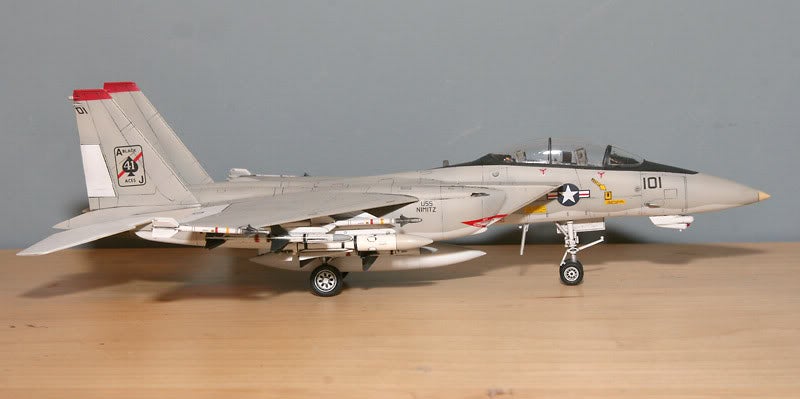
 ttyymmnn
> user314
ttyymmnn
> user314
12/24/2019 at 13:23 |
|
Thanks for the photos. I never did research any of the other concepts. f86sabre suggested that there are so many first flights this time of year because they had to get it done by the end of the year due to funding. I wondered if it was also due to favorable weather in the desert.
 user314
> facw
user314
> facw
12/24/2019 at 13:41 |
|
According to the AMARG Experience site (last inventory update was 12/18/19) , there are 10 F-14s of various models still in storage, although the NF-14A entry is blank, so that might actually be 9.
 facw
> user314
facw
> user314
12/24/2019 at 14:30 |
|
Just for fun, from the most recent Google Earth images (8/18/2018, so a bit out of date):
Two in their little museum line:

One south of those in a more sort of gate guardian pose:

Five southeast among the bombers and C-5s:

And two very sad ones stashed in a fenced enclosure with some A-4s on the south side of the base:

If I can do math, that accounts for all 10 (unless they’ve disposed of one since these photos were taken).
 user314
> facw
user314
> facw
12/24/2019 at 14:45 |
|
Ugh. F or all the actual and potential destruction they represent, there’s still something almost barbaric about seeing those BUFFs looking for all the world like they w ere dissected and left to rot .
 LastFirstMI is my name
> ttyymmnn
LastFirstMI is my name
> ttyymmnn
12/24/2019 at 15:56 |
|
Probably just a sign of when I happened to be 12 years old, but the F-14, SR-71 and B-1b are three of the best looking aircraft ever built.
 Only Vespas...
> ttyymmnn
Only Vespas...
> ttyymmnn
12/24/2019 at 18:50 |
|
Great Job T-Man, as usual. I read somewhere that the parking area for aging F-14s in their last years was called Jurassic Park.
 facw
> user314
facw
> user314
12/24/2019 at 21:20 |
|
The guillotine is sort of cool though:
 winterlegacy, here 'till the end
> ttyymmnn
winterlegacy, here 'till the end
> ttyymmnn
12/28/2019 at 01:37 |
|
No problem!